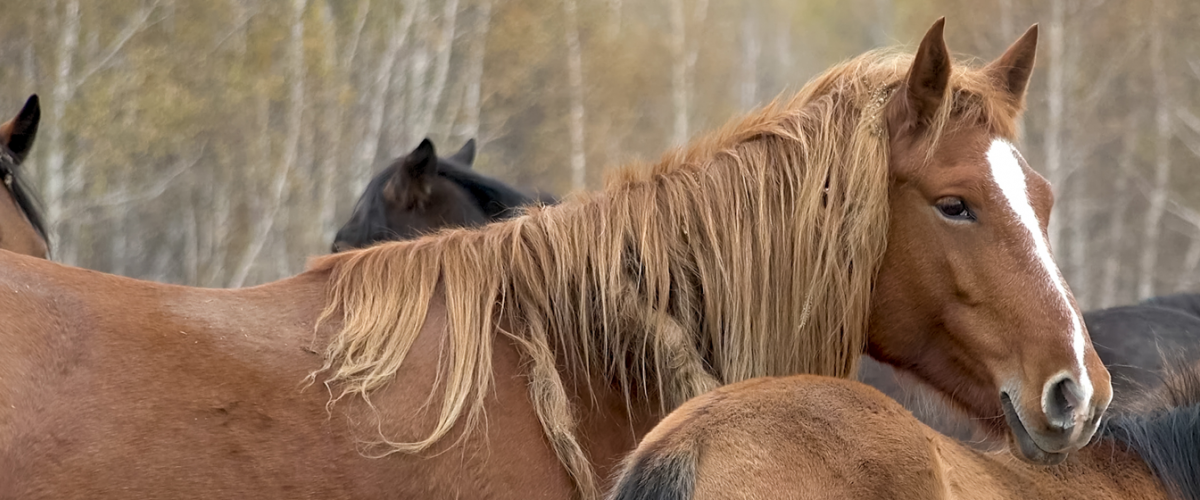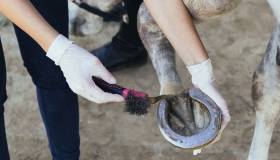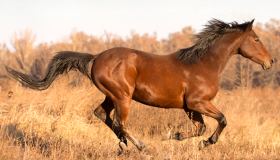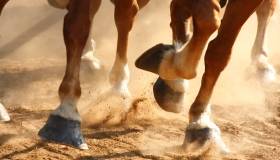
January 31, 2019 – Horses need four legs to stand on – seriously. Foot and leg diseases or injuries in horses can be devastating problems, severely impacting a horse’s quality of life or even leading to euthanasia. And there is no more crippling or life-threatening problem than laminitis, commonly known as founder. Laminitis is one of the most common diseases seen in horses and has been recognized and described for more than 2,000 years.
Laminitis is a disease of adult horses and ponies and is associated with inflammation of the laminae of the foot – the soft, delicate, sling-like tissue structures that attach the coffin or pedal bone to the hoof wall. When the laminae are injured or irritated, the resulting inflammation and hoof damage can cause extreme pain and may lead to instability of the coffin bone within the hoof. In severe cases, the coffin bone separates from the inner wall of the foot and perforates through the bottom of the hoof.
Morris Animal Foundation long ago recognized the seriousness of this problem and began funding laminitis health studies in the early 1970s. At that time, most researchers were trying to figure out the causes and biological mechanisms involved in disease progression to find out how to slow or halt the disease. Although there are no definitive cures yet, our work has helped find ways to better manage affected animals, especially if caught early.
Much of our early research focused on diet, something that we now know is a key trigger for some forms of laminitis. Over the years, our research focus has shifted to equine metabolic disorder (EMS), characterized by high concentrations of insulin in the blood, which can predispose horses to developing laminitis. EMS now is considered one of the leading causes of laminitis.
Laminitis occurs in virtually all breeds and, by some estimates, affects about 15 to 20 percent of horses over the course of their lifetime. A genetic predisposition has been identified in some breeds, including Morgan horses, Tennessee walking horses and some pony breeds, but the search for causative genes remains elusive. We currently support work searching for genetic risk factors for equine metabolic syndrome, since understanding one of the major causes of laminitis might hold the key to eliminating and preventing this terrible disease.
Laminitis is extremely frustrating for both equine veterinarians and horse owners because there are still many unknowns about the disease, making it difficult to prevent and treat. What we do know is there are several possible triggers for laminitis. Sometimes inflammation associated with other illnesses, including colic, pneumonia and retained placentas in brood mares, can create sudden onset of laminitis. Injury to one limb can make a horse transfer its weight to and stress a healthy limb, leading to laminitis in the healthy leg. Horses with metabolic conditions, like EMS, are at a higher risk for laminitis. Repetitive trauma, usually associated with hard surfaces like roads, also is a cause of laminitis.
Warning Signs of Laminitis
- Hoof warm to touch for more than a few hours
- Strong, throbbing digital (foot) pulse
- Foot lifting, both too little or too much
- Change in stance
- Reluctance to move
- Distorted hoof shape
- Abnormal rings on the hoof surface
- Fever and severe watery diarrhea
Although these signs are not all specific to laminitis, call your veterinarian immediately if you note any of these signs. The earlier this disease is caught, the better the chance you can slow or stop its progression before it causes lasting damage.
Depending on the clinical signs, your veterinarian may take X-rays to see if the coffin bone within the hoof has detached and rotated. Initial X-rays also help your veterinarian gauge if your horse is responding well to treatment and care. Further diagnostic tests, including blood work, can help your veterinarian detect predisposing diseases, such as EMS.
Depending on the suspected cause, disease management includes controlled diets, meticulous foot care (work closely with your farrier), and anti-inflammatory drugs to manage inflammation and pain.
Currently, Morris Animal Foundation is supporting laminitis studies looking at the roles of diet and insulin, the gut bacterial composition in horses with equine metabolic syndrome, and links between environmental chemical exposures and disease.
Learn more about our equine studies, generously funded by passionate donors, and how together we are helping horses all around the world affected by laminitis and other serious equine diseases.




